Exterior stains provide a dual purpose; they enhance your project’s appearance and help protect the underlying wood from damage done by the elements. Wood will fade, warp, and split with too much UV exposure and quickly rot from constant moisture ingress. Most exterior wood stains will provide a waterproofing agent and pigmentation to help block the sun’s rays.
When selecting a stain, you have some technical decisions to make. First, whether to choose a water or oil-based product; second, how environmentally friendly you wish to be; and third, how much UV you wish to block. Let’s look at these in turn.
Oil or Water-based Stains
Like paint and finish coats, stains come as water- or oil-based products. Each has its pros and cons:
Oil-based stain
Pros
- It is cheaper than water-based stains, usually up to half the cost.
- Easier to apply, particularly over rough and uneven surfaces.
- Oil-based stains are more durable than water-based products.
- You get a faint surface luster with oil-based products that you don’t with water-based.
Cons
- The surface must be completely dry, or you’ll get bubbles that mar the finish.
- You’ll need mineral spirits or paint thinner to clean up.
- Oil-based stains emit more fumes that can irritate your eyes and breathing.
Water-based stain
Pros
- You can apply it over slightly damp surfaces without impacting the finish.
- Fewer fumes, so less irritating to eyes and breathing.
- Cleans up in water.
Cons
- Less durable than oil-based products
- More difficult to apply on rough and uneven surfaces.
- Expensive.
- Matte finish only.
Environmental Impact
Vaporized chemicals from some paints and stains react with sunlight, nitrogen oxide, and carbon monoxide to impact air quality. This creates ozone in the earth’s lower atmosphere, a byproduct called smog. The name given to photochemical reactive components is volatile organic compounds (VOCs), and in the US, the EPA regulates the emission of VOCs.
While the EPA doesn’t regulate VOC emissions from paints and stains, manufacturers voluntarily seek to reduce their products’ VOC emissions. It’s not uncommon to see labels on the tins claiming no or low VOC; these products are healthier for our atmosphere and the people who use them.
No VOC or zero VOC products should contain less than 5 grams per liter.
Low VOC products contain less than 50 grams per liter.
Some particularly high VOC products can exceed 250 or 300 grams per liter.
UV Blocking Characteristics
You’ll also see stains that describe themselves as transparent, semi-transparent, or solid; these terms describe the stain’s pigmentation level.
The solid stains are almost paint-like in their coverage, offering great UV protection but hiding much of the underlying wood. Semi-transparent stains have less pigmentation and, thus, less UV protection, but the wood grain and color are more apparent. The transparent stain has the least pigmentation and offers the least UV protection of the three, but you can see the wood color and grain through the stain.
Our Choice: Best Exterior Wood Stain
| Category and Product | Summary |
|---|---|
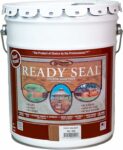 Best Exterior Wood Stain – Ready Seal 525 | In our opinion, Ready Seal 525 is the best all-rounder exterior wood stain. It’s inexpensive, has a great range of colors, an acceptable coverage per gallon, and its recoat time gives you just enough time for a quick coffee before you start again. Self-blending, no primer, no back-brushing, and no banding. What’s not to like? |
The Best 6 Exterior Wood Stains in the Market
To assist you in making your exterior stain selection, we reviewed six products for price, coverage, color range, and effectiveness. Finally, we chose the stain we consider the best all-rounder.
| Wood Stain | Coverage sq ft/gal | Recoat Time | Cost |
| Ready Seal 525 | 125 – 175 | 45 mins | * |
| Defy Extreme | 150 | 15 mins | ** |
| Ronseal Quick Drying | 680 | 4 hours | **** |
| Thompson’s Water Seal | 400 | 2 hours | * |
| Cabot 19202 | 500 | 15 minutes | *** |
| Wood Defender 200 | 175 | N/A | ** |
Ready Seal 525
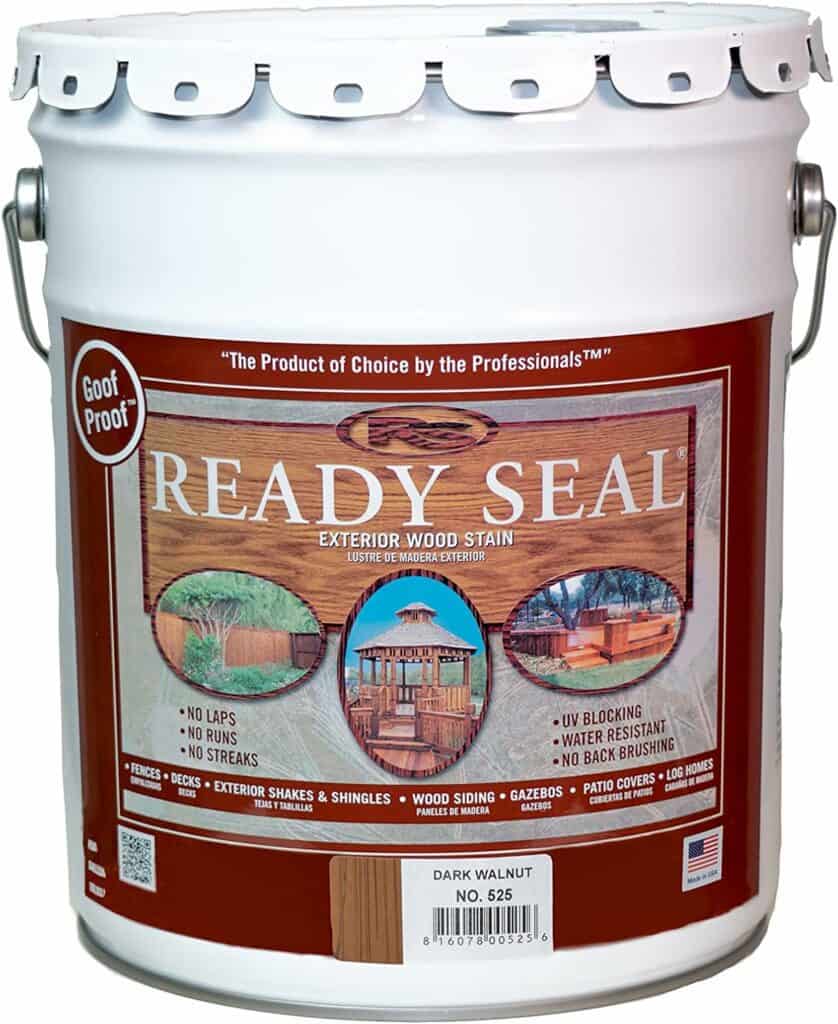
Ready Seal 525 is an oil-based semi-transparent exterior stain and sealer that requires no primer before application. It is self-blending, so it doesn’t require special techniques like wet-lining to prevent banding and won’t require thinning before spraying. You can use brushes, rollers, or sprayers to apply it, using two light applications allowing 45 minutes between coats. Ready Seal 525 will take two to three days to dry and appears darker upon application but lightens to its true color in two weeks. You’ll cover between 125 and 175 sq ft per gallon, depending on the type of wood.
Pros
- Meets US VOC requirements
- No primer required
- Short recoat time
- Biodegradable in soil
- No thinning required
- Easy application
- No back brushing is required
Cons
Mineral spirits required for cleanup
Defy Extreme Wood Stain
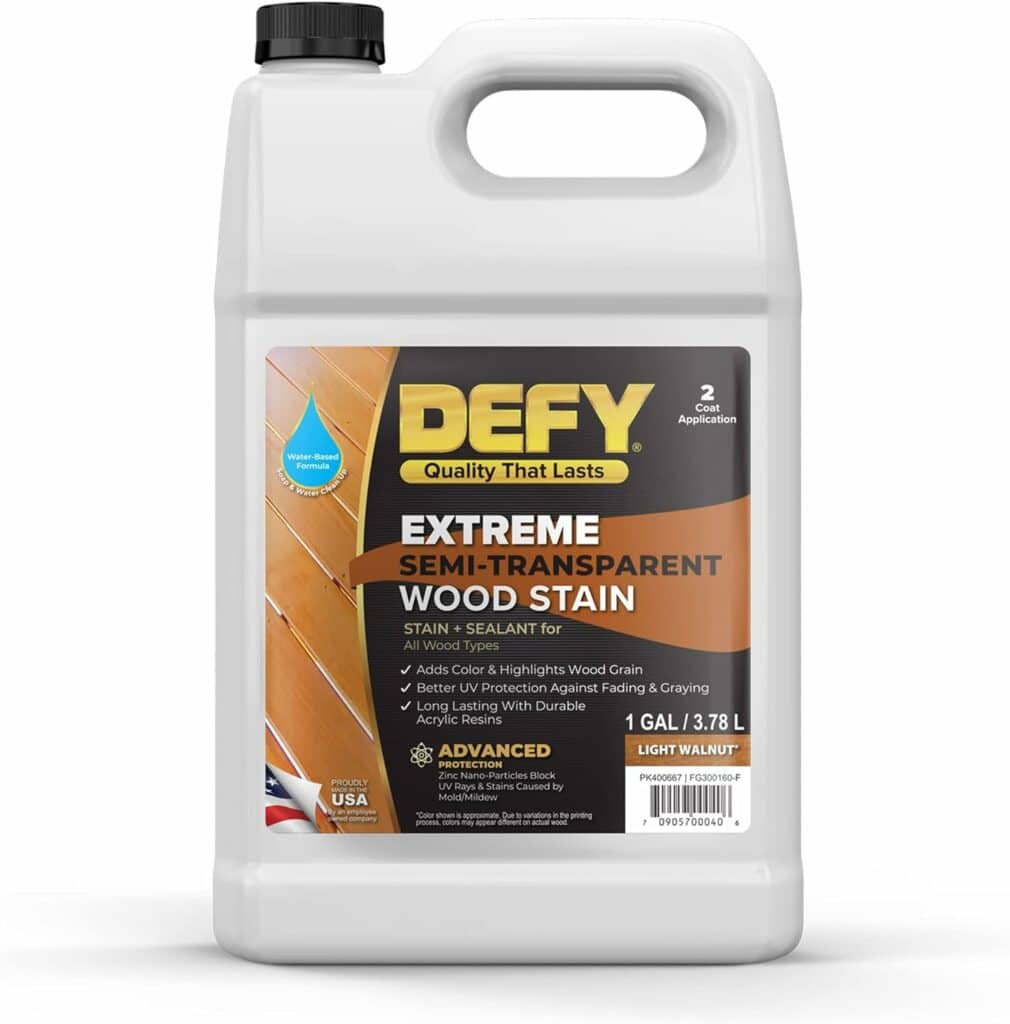
Defy Extreme Wood Stain is a water-based semi-transparent exterior stain claimed to be rain-proof four hours after application. The manufacturers claim that despite being semi-transparent, the stain contains ‘zinc nano-particles’ for protection against UV rays that can fade and split wood. Do not apply to newly milled timber; use kiln-dried timber or leave it to weather for three to six months. Do not thin this product or use it when the wood is damp or rain is expected within 12 hours. Apply with a brush, pad, roller, or sprayer and back brush to apply a uniform application. Apply a second coat while the first is still wet, usually within 10 to 15 minutes.
Pros
- Water-based formulation
- Short recoat time
- Short drying time (24-hrs)
- VOC compliant apart from California
Cons
Requires back brushing
Ronseal Quick Drying Woodstain
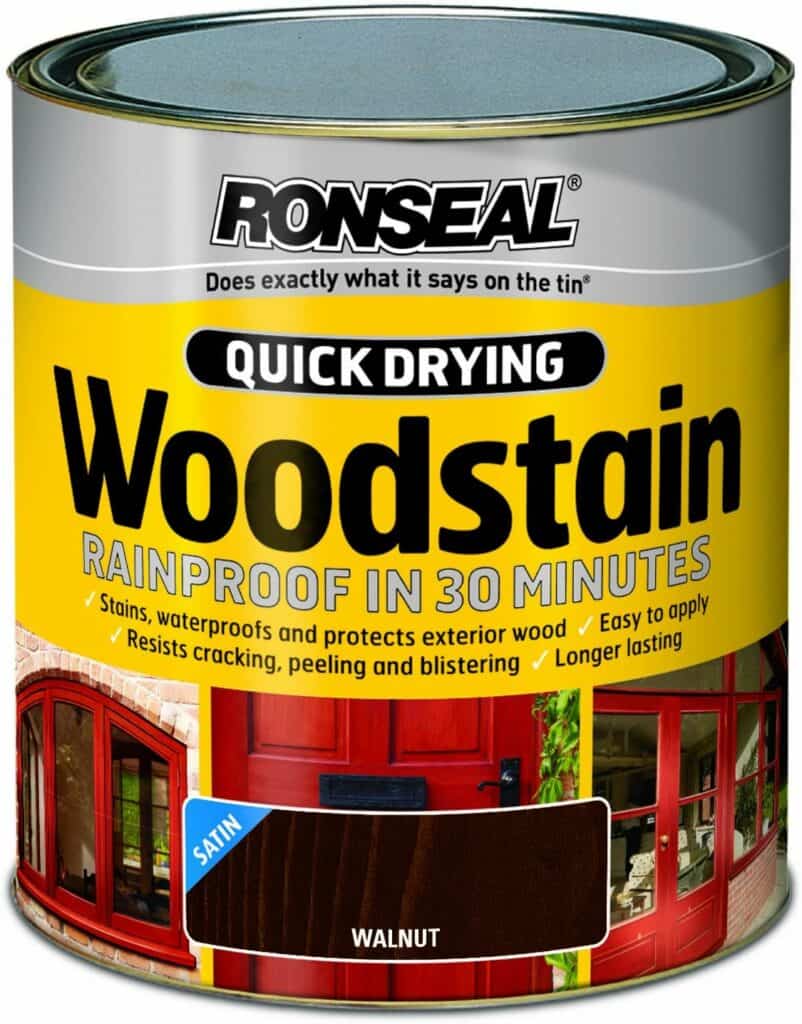
Ronseal Quick Drying Wood Stain dries in four hours and is rain-proof in 30 minutes. It does require three coats, however, when compared to the competitors. It’s also eye-wateringly expensive, so even though the coverage claims are huge (and unverified), it still works out about 30 to 35% more than its competitors. You should sand between the second and third coats to smooth the surface and help the top coat stick. Reviewers seem to like the product, although most comment on its cost.
Pros
- Good range of colors
- Quick drying
Cons
Expensive
Thompson’s Water Seal
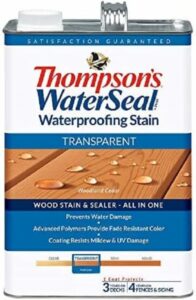
Thompsons Water Seal Waterproofing Stain is touch dry in two hours, although you shouldn’t apply it in direct sunlight or on particularly hot days. It has good coverage, is not expensive, and can be recoated in two hours. Thompsons suggest only one coat is required and that it is important to keep a wet edge when applying to prevent lap marks and color banding. You should not thin this product, and if staining a large area, intermix all cans to ensure uniformity of color.
Pros
- A short recoat time
- Good coverage
- Not expensive
- Only one coat needed
- Exceeds ASTM D-4446 for Waterproofing Wood
- Resists Mildew and UV Damage
Cons
Can’t apply in direct sunshine
Cabot 19202
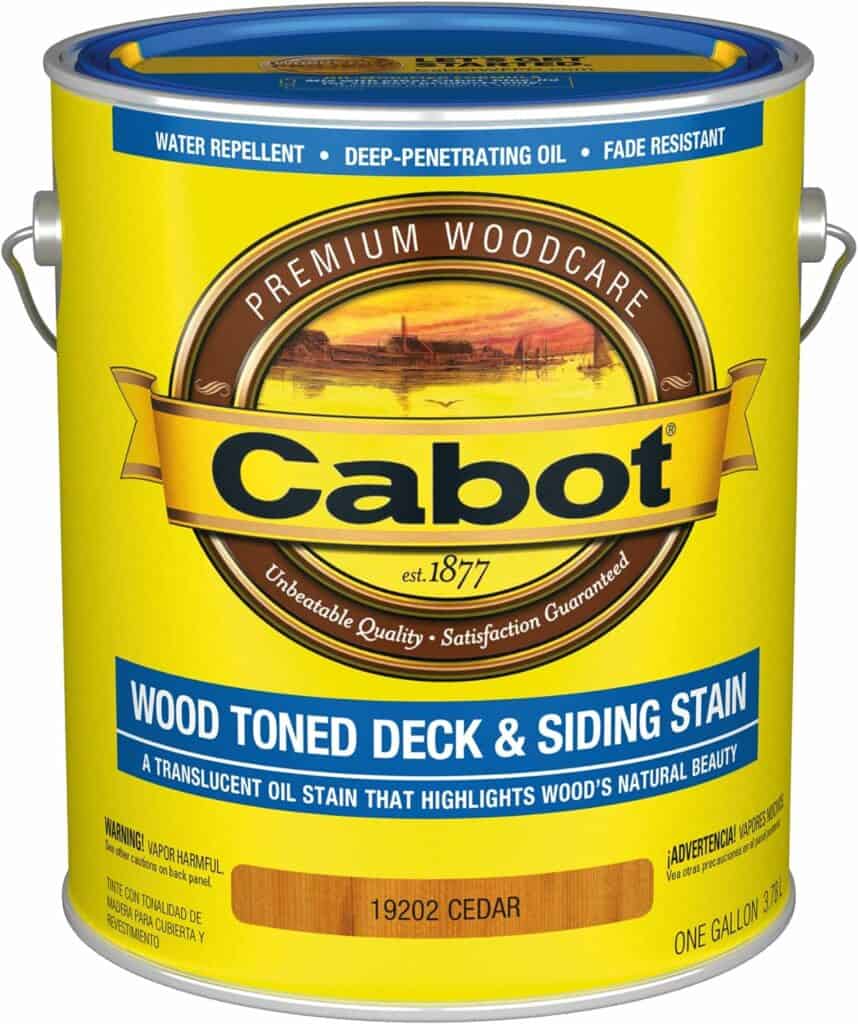
Cabot 19202 is a translucent oil and resin-based stain for use on exterior wood. It comes in five colors and has great coverage, needing only one coat. It is a little fussy about the wood preparation, requiring it to be below 15% moisture content and scrupulously clean for the best effect. If spraying this product, immediately back brush to gain a uniform cover and color. New timber or unseasoned wood should be allowed to weather before applying the stain, although no longer than three months. Cabot 19202 takes 24 to 48 hours to dry.
Pros
- Oil-based to nourish the timber
- Only one coat is required
- Great coverage
- Low VOC
Cons
- Mineral spirit cleanup
- A little more expensive than some competing products
- Long drying time
Wood Defender 200 Series Stain & Sealer
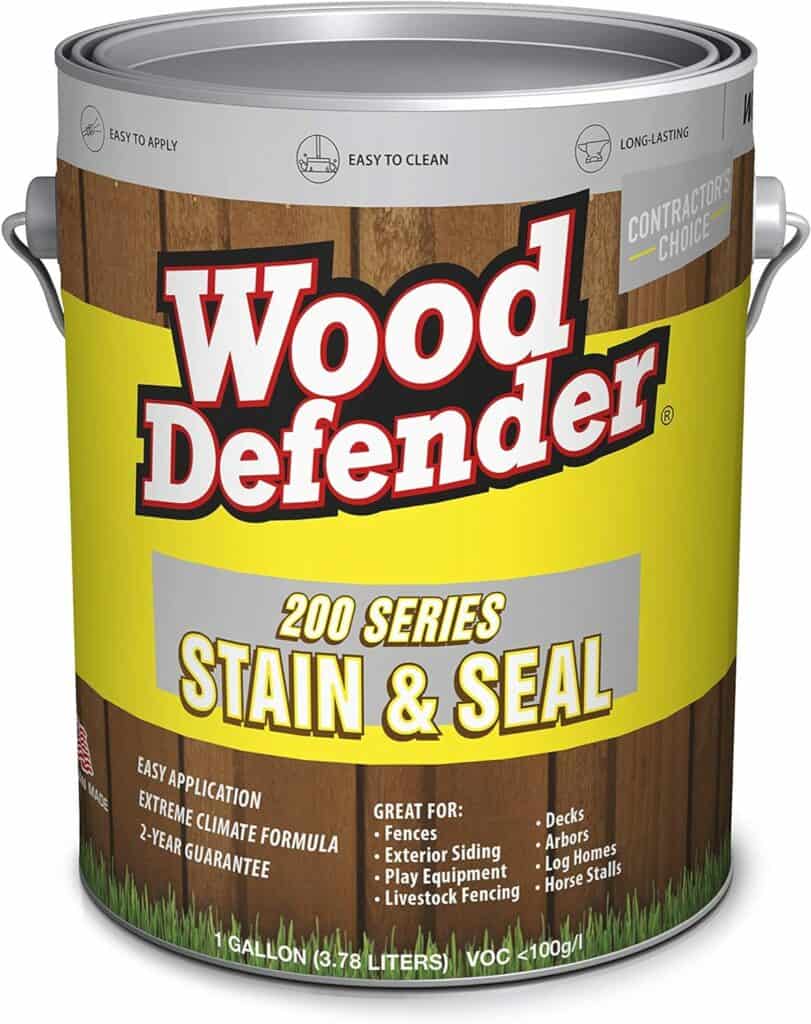
This Wood Defender Series 200 stain and sealer is an oil and resin-based product that you can buy in four colors and with a transparent or semi-transparent pigment. The coverage rate is not as good as some of our other contenders, but it’s not bad, and the price per gallon is average. Only one coat is required, with no back brushing. Wood Defender 200 has low VOCs and dries in 24 to 48 hours.
Pros
- Oil-based to nourish the wood
- One coat only needed
- No back brushing required
- Low VOCs
Cons
- 24 to 48-hour dry time
- Mineral spirits required for cleanup
Frequently Asked Questions
No, all stains are not suitable for outdoors. Outdoor stains are specifically designed to hold against outdoor factors like UV rays and humidity; Interior wood stains do not include UV absorbers, mold retardants, or HALS and are designed for indoor usage.
Yes, you can stain weathered wood. To stain weathered wood, you need to clean the surface using wood cleaners, scrub the surface with a stiff-bristled brush. And then rinse the wood surface thoroughly. Once the surface has completely dried, you’re ready to coat with a stain.
Yes, you can stain wood without sanding, but it depends on the situation. If the wood is already stained and you are reapplying stain, you can stain wood without sanding.
For bare wood, it is best to sand before the application of stain. Many people make the error of sanding to grit that is either too fine or not fine enough before adding stain. If the grain is too fine, the stain will not adhere to the wood.
Although a topcoat sealer is optional, it protects the stained wood from scratches and prevents fading over time.
Depending on the situation, you have to seal the wood after staining because the wood remains a porous surface. When compared to completely unfinished wood, a regular stain can provide some protection. However, it is insufficient.
Primers are a thin coating that is applied before painting or staining with a solid color. Primers improve the durability of paint or stain by ensuring better adhesion to the surface. It’s important to remember that primers aren’t required for a wood stain treatment, especially if the desired finish is meant to reveal the natural wood grain.
Yes, wood stains are suitable for outside. Wood stains come in a few varieties: water-based or oil-based. I would recommend using oil-based wood stain outdoors because of its resistance to elements compared to water-based stain.
First, to remove mildew spores, scrub affected surfaces with a combination of 1L household bleach and 3L water. The Wood needs to be dry; when the stain is applied to wet surfaces, it does not adhere well and will crack or peels.
Premature wood rot and decay can be caused by moisture. So, before staining the wood, make sure it’s completely dry. Look for any holes, cracks, splits, or loose joints that require attention; use wood filler to fill the gaps in the wood.
It’s always best to finish these before sanding your wood project. Sand external wood surfaces following the grain once the surface is clean and dry; brush the whole surface to remove any sanding residue. Sanding is an important part of the wood preparation process. It removes minor nicks and scratches, smooths out the dried wood filler, and opens the wood’s pores to accept more stain.
Sanding also removes the surface glaze formed when the factory’s planer blades come into contact with the natural resins in the wood. This glaze, if left un-sanded, can prevent the stain or finish from penetrating the pores. After sanding, the wood can be stained. Pay attention you use wood fillers that are stainable.
Most of the time 2 coats of stain are applied to the wood. Hardwoods are particularly thick and may only be able to absorb one layer of wood stain. The number of coats also depend on the thickness of the stain and the amount of pigment present in the stain.
For beginners, I would recommend roller and brush combo. Rollers are a great way to apply wood stains because of how quickly they can be applied.
When you have hard-to-reach regions, however, employing rollers might be a drawback. If you’re going to apply your stain using a roller, make sure you have a brush on hand for those hard-to-reach regions.
It’s also possible to use a sprayer to apply the stain. If you’re going to use a spray, make sure it’s on low pressure and that you’re staying near to the wood. Sprayers are fast and can apply stain to narrow locations; however, one of the major drawbacks of utilizing one is overspray. Make sure to protect all the surrounding items from the over-spray.
Both staining and painting have their pros and cons. While staining takes less time and is cheaper per gallon compared to paint, paint performs a better job of filling in cracks, hiding defects, and providing longer-lasting protection.
Paint is also more rot resistant and better at avoiding mold and UV damage than wood. For existing wood projects, the easiest solution is to utilize the same paint or stain that was originally done. Staining previously painted wood requires a lot of sanding and priming. Switching from stain to paint is not difficult if your property was previously stained.
On new projects, the product you pick should be based on your aesthetic goals. Use a semi-transparent stain to bring out the inherent character of the wood. Use a solid-color stain for easy maintenance or paint for a stronger barrier, consistent color, and longer protection.
Most stain is applied with a brush, a roller, or spraying. The manufacturer’s instructions will advise the best method to suit your chosen stain.
If you’re applying a dark stain over a lighter stain, it works perfectly, but if you are applying a lighter stain over a darker stain, it will not work. You need to strip the wood of an older, darker stain shade before applying a lighter shade of the stain.
Exterior stains have added UV blockers and water resistance. As interior stains don’t live in harsh conditions, they lack these features. Should you use an interior stain outside, the finish will not last long, and you’ll provide considerably less protection to the wood.
Cedar tone and Brown tone stains are by far the most popular deck stain colors but it might not be right for you, you’ll want the color of your deck to complement your house color.
By selecting a complimentary tone rather than an exact match, you can guarantee that your deck has just enough contrast to stand out from the rest of your house.
Your wood must be clean and dry. That means all dirt and residual paint should be removed by washing and scraping. If you want a smoother surface, you can sand the wood, which helps remove dirt and residue. As most stains work by penetrating the wood, the timber must be dry to ensure the stain is soaked up; usually below 15% moisture content. However, some stains can be applied to damp wood.
Stain and preference depend on various factors like wood type: It’s critical to choose a suitable stain base before applying a stain to your wood.
In the debate between oil-based stains and water-based stains, a water-based stain is the best option if you’re covering a wood that has a natural resilience to rotting. Cedar, cypress, and redwood are examples of this type of wood.
Previous Stain/Paint: If the wood you want to stain already has a coat of paint or stain on it, you’ll need to take some extra steps to get a new, even layer of protectant. Although identifying the previous coating may be challenging, it will aid in your decision between oil-based and water-based stains. A water-based stain will stick better to an oil-based previous coating and should be applied.
Exposure to Elements: The weather that the wood will be subjected to will also influence which stain base is appropriate for your project. If the wood will be exposed to the elements such as wind, rain, and sunshine, an oil-based stain is the best option.
This is because it is more lasting than water-based and gives a more comprehensive protection layer against these elements.

Thank you for posting this information Mr Stewart. We are looking at board and batt siding. Of course we need weather and UV protection. Given our age we preferentially desire many years as we can get from northern Montana weather before needing to reapply. Which product can you recommend for the board and batten exterior finish?
Hello Bill & Linda, I would recommend this excellent product by Ready Seal.
It is all in one water-proof sealant and stain with anti-mildew/anti-mold and UV protection. It will last years.
What would you recommend for exterior cedar log cabin. Not much shade around cabin, located in the U.P. of Michigan. Could I just power wash and apply Ready Seal or would I need a primer put on first. Have you heard of x-100? Used this year’s ago, seamed to last ten years. Cabot only lasted two years.
Hello Michael,
You can use this product by Ready Seal, just remove any remains from the previous coating. It doesn’t require a primer before application. I have heard good things about x-100, I will be testing it shortly.
What is your opinion & critique of Sherwin Williams’ “Woodscapes” polyurethane semi-transparent stains?
Hello Scott,
It depends on the wood, type of surface, whether it is reapplication or first application.
Can you be specific about your use case? I can give my opinion on the product based on your specific case.
Hey William,
Really interesting post.
So I’ve just had a new wooden porch/canopy (with tiled roof) put on over the front door of our house which is south facing and exposed to a lot of sun. Which of the above would be most appropriate…I get lost in the descriptions in terms of whether something that is good for furniture/decking would work on a wooden canopy!?! Looks like they all have good degree of UV protection…just don’t want to buy the traditional off-the-shelf products from a diy shop!
I look forward to hearing from you.
Hello Paul, great question.
What type of stain you use depends on whether your wood is pressure treated or not.
For a wood that is not pressure treated I would recommend this one by Ready Seal and for wood that is pressure treated I would use this one by Thompsons.
This requires wood preparation before application, it is also mildew resistant and offers protection from UV damage. It also dries to the touch in 1-2 hours.
Great post William, if I was making bath boards from pine / reclaimed pine, what would you recommend to ensure waterproofing/ mould resistance
Thanks
Tony
Hi Tony.
If you want to stain your board with a stain you can apply this sealant and for even better protection then cover with a transparent sealant use this one or if you do not want a stain you can only wear a transparent sealant.
This sealant is intended for external use so that it has good resistance to water and mold. When applying, be in a ventilated place. Once dry, there are no harmful fumes (of course it is harmful if swallowed :))
Question – I have a pine log cabin style shed (6mx6m) finished with several coats of a water based clear matt varnish only a year ago which has weathered off with ‘bare’ patches now as well as wee grey bits and overall bleaching in colour. It is a sort of light golden overall now. I am keen to protect it from further damage this winter but would have great difficulty sanding the existing finish completely off. I am keen to keep the natural wood grain showing and a light colour but appreciate may need to stain and finish with something to protect better (in a sunny but windy spot in Scotland) and hopefully that will last a long time. Are there any stain and protection product (s) that would give a natural pine (ideally matt) look but last? I appreciate may need to go a bit darker than it is now but keen to keep a nice pine colour if possible (ie not too antique or red or orange etc). Finding internet search very confusing and companies I call always just recommend their own product so hope you can help!
Hi Ian.
You can use this stain by #1. It is especially suitable for conifers and gives good protection. In addition, for a better result (without sanding), a kit for removing the old coating and lightening the wood is available, so you will have a really good result.
After applying the stain you can apply a transparent sealant to give additional protection and protect the color. This way you will be able to renew only the transparent coating without darkening the color or having to remove the stain. Of course, all this will happen if you renew the coating on time and it is not in a hellishly miserable condition.
This sealant by Rain Guard can do the job for you.
I am building a shed with plywood siding with 1×2 batten boards nailed on. We would like to waterproof/ seal/ stain it a darker brown color. I have a airless sprayer also. Any advice would help , thank you
Dave
Hello David.
I think a stain with a sealant like this one by DEFY will work well for you, you can apply it with a sprayer.
Keep in mind that applying with a sprayer will save you a lot of time and effort, but you must be careful and apply evenly. Uneven application leads to poor appearance and poor protection of the wood.
If you have no experience in spraying you can try in a place where it is a little visible. In case you apply unevenly (drops are formed in some places and in others, it is almost dry) you can spread with a brush while the stain is still wet. That way you will have a plan B.
We are putting up a Shed in our backyard. It is under trees and will get southwestern Ontario weather. We plan on finishing with board and batten on the outside but would like a red stain finish. We are not interested in refinishing every few years. What product would you recommend?
Hi Jody.
You can use the Thompson’s seal to accord color and protection, and for longer-lasting protection (without darkening the color) you can apply a transparent sealant.
The thicker layer will give you a longer life. The shade of the trees will probably help too.
Keep in mind, however, that the life of the coating depends on the correct application and how harsh the weather conditions are.
Hi William, my question is… we have a covered back porch with plexiglass windows, used Benjamin Moore paint to paint the inside walls and it looks great. But wood floor needs an update. It had previously been stained years ago so some stain is worn off in the high traffic area and around the sides is darker. I hate prepping. I just want to put a stain on that will last and look uniformed. Thanks
Patty
For the best outcome, I would strip the stain before reapplying but its not necessary. Some good brands of stain to use are Minwax and Varathane.
IMG_8316.jpg IMG_8317.jpg IMG_8398.jpg
I hope these pictures show up. These were taken a couple years ago and now the outside of my house needs to be done again.
I would like a recommendation on a product to use to get a long lasting weather proofing, good in harsh Canadian winters and hot summer sun without fading and having to re apply all the time.
I would suggest using a spar varnish for the best protection. Spar varnish is good for water resistants and UV protection. I would recommend a spar varnish by Man-O-War or Minwax. If you don’t want to use spar varnish, this weatherproofing transparent wood finish by Behr is a good option too.
The stain on our 7 year old (covered) deck needs to be redone. The contractor used Behr product. Do we have to use the same product to redo it? The parts that are not covered like steps/railings have no stain left. We thought we would redo this ourselves. Thanks for your help.
You don’t have to use the same stain brand to redo it but I would suggest it for the best results. Behr is a really good brand when it comes to stains and sealers but it can be a little expensive. If you are looking for another good brand for stain I would suggest anything from SaverSystems, Kilz or Thompson’s.
Hey William thanks for putting together some great resources. I am in a pickle. We have 3000sqft of new pressure treated pine fence. I want to take the steps to protect it. I would like to try and preserve its color along with protecting the fence but I am on a budget and if I can only do one I’d rather protect it from rotting. I know ready seal seems like the go to option for me but with the amount of coverage I need and how expensive/lack of coverage per gallon ready seal offers I’m looking at other options. Also if you buy stain and a clear sealant separate which one do you apply first?
What do you recommend for me?
Thank You!!
Hi, Avery.
For you I would recommend Agra-Life Lumber Seal . It’s a sealer which covers 2-3 times more than Ready Seal stain/sealer does. So if the coverage is your main concern then Agra-Life is the best choice, it’s great for fences.
Apply sealer first, after that apply water-based wood stain.
Great post, go on writing, William.
I’ve got a quick question. My VERY old wooden fence was barely finished as a result it started rotting and fall apart. The best solution was to replace it with new fence completely which I did. Now I want to finish it properly to avoid the same problems in the future. What stain would be the best for staining a fence? Also I know that sealer is must have for exterior wood that’s subject to weather and moisture. Wait for your answer, thanks.
Thanks, Jacob. Glad to see you on my blog. You made the right decision: when wood starts decaying because it wasn’t prepared the right way initially it’s better to do all from scratch again. But sometimes it’s possible to repair wood using putty and other material, but fence isn’t a subject in this case: too much work, you know.
You’re right, it’s highly recommended to use sealants for exterior wooden projects. But many exterior stains can seal wood too. ‘Ready Seal Stain and Sealer’ seems to be made especially just for you. It’s great for exterior pieces like fence. Furthermore, it both stains and seals the wood so you won’t need to seek for good sealer. So pick up Ready Seal and you’re ready to go.
Anyway, if you want to fint out more about sealant, you may read my article on them https://woodimprove.com/best-wood-sealers/
Hi, Rebeca. It’s better to use foam brush or rag to apply gel stain but some brands may be applied using fine bristle brush without problems. By the way, I applied Old Master last time using exactly bristle brush, finish went easily and evenly.
I suppose Old Masters might have changed their formula so that consistency of the product got more sticky. But most likely your stain wasn’t warm enough for proper finishing. It’s spring but weather is still chilly so do not use finishes once you get them delivered, let them warm up at room temperature. If you do so, the finish will perform at its best.
So, try to warm up the stain. If it doesn’t work, you need to switch the bristle brush with foam brushes and rags. You might have already seen my article on brushes for staining https://woodimprove.com/best-brushes-for-staining-wood/. Please, take a look, you will find at least one foam brush option there. What about rags, so I think it isn’t a bit deal to get them